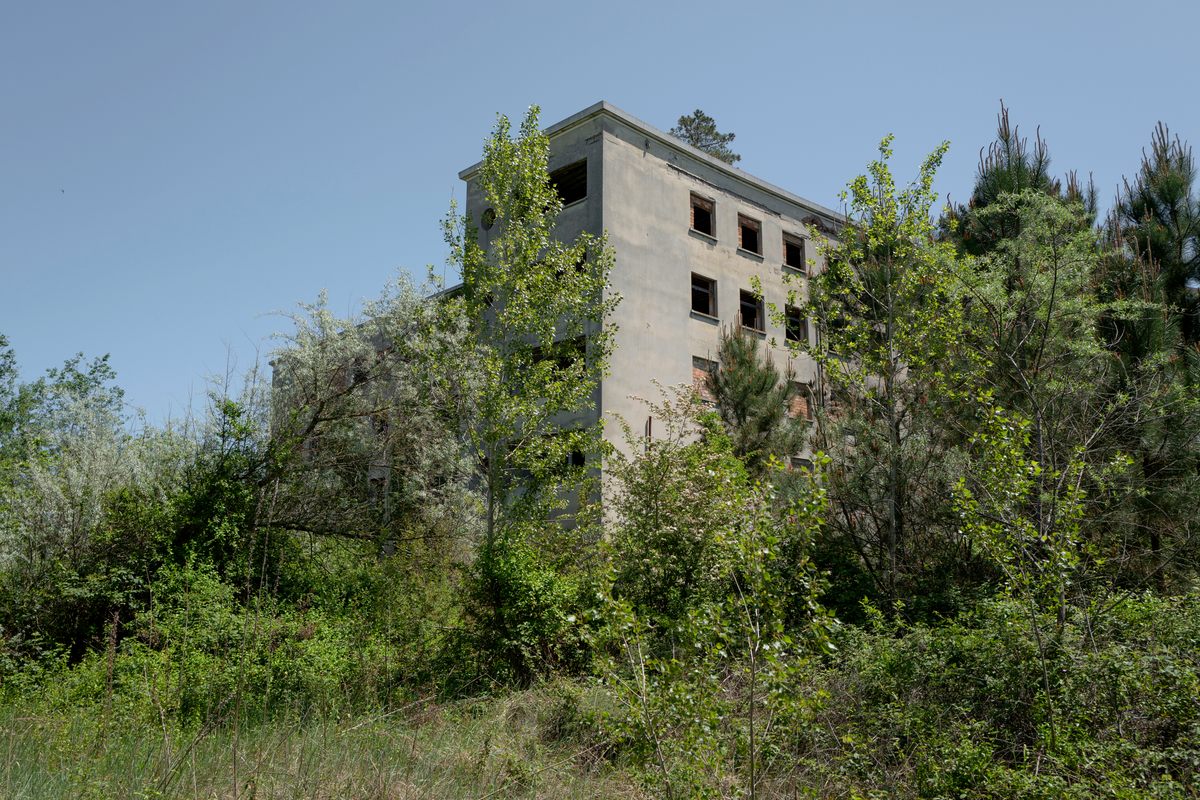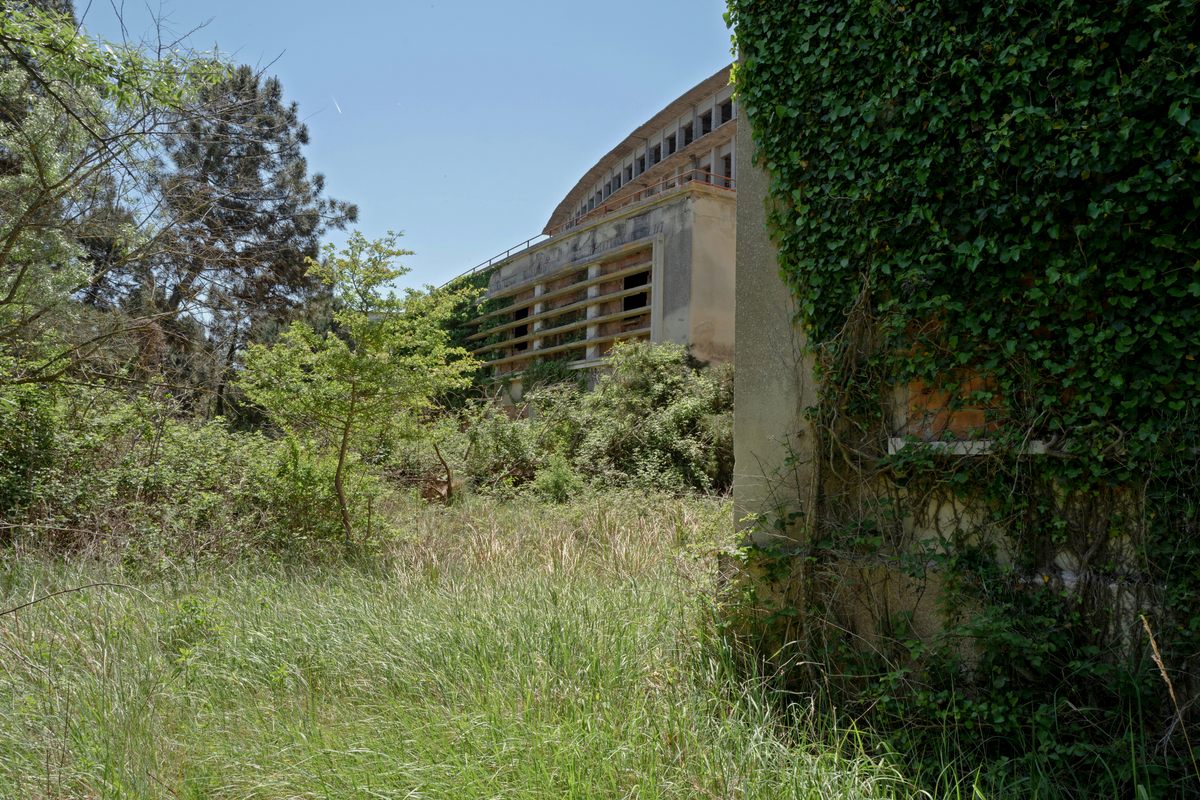
A Tour Through Italy’s Massive ‘Museum of Abandonment’
The organizers posit that “derelict heritage” can be a path to rejuvenation.
Pierfrancesco Cenni flicks a switch on a portable fluorescent lantern, turns a knob to increase its intensity, and heads into the dark. “Use your phones’ flashlights, and put your feet where I put mine,” he calls out as he descends into the cool, damp underground air. At the bottom of a narrow flight of concrete stairs, with another flick, he turns on a massive fluorescent lamp, revealing a vast, two-story chamber, where thick cement pillars shoot up from bare earth into the darkness and girders hold up the ceiling.
We’re in what remains of the Underground Cinema-Theater, a venue designed to bring new life to the center of Imola, northern Italy, in 1935, at the height of the country’s fascist regime. But it was left unfinished when the outbreak of World War II turned locals to more pressing concerns. “My grandfather bought it in an auction in 1954,” Cenni says, as water drops, tick-tock, in the dark distance. He had hoped to bring it back to life, but Cenni’s grandfather died of a stroke during Sunday mass a few years later. As time went, modern fire and safety regulations made it harder and harder to use the space, while the bill to complete it ballooned to tens of millions of euros. It was more than Cenni, a civil lawyer, has the capacity to front. Local authorities have only shown vague interest in taking over the property, so it has been left behind, unable to serve a purpose but certainly holding a story.
In the last year and a half, the theater has joined forgotten fascist monuments, derelict mountain cemeteries, and empty, disused nightclubs to become a centerpiece of a new outdoor museum: the In Loco Widespread Museum of Abandonment. “These places hand down not just themselves, but also memories and stories,” says Francesco Tortori, who works part-time as a fundraiser for an international NGO and doubles as the president of Spazi Indecisi (“Undecided Spaces”), the association behind the museum. “They show how man interacted with the landscape, with little attention, and left behind remnants. We think that these ruins of modernity can tell the story of a land.”

Italy is full of ruins, ancient, yes, but modern as well. Tortori says that because of its huge number of landmarks and historical monuments, Italy has developed a fastidious approach to heritage preservation, and the government’s cultural heritage department imposes renovation restrictions on many, many buildings. Combined with the country’s legendary red tape, Tortori says, this makes it easier to erect new buildings than to renovate protected sites. As a result, countless places are left behind. No accurate statistics exist, but Italian media has estimated the country has between two and 14 million abandoned buildings.
They’re left behind for a variety of reasons: corruption, war, cultural shifts, sudden deaths, or laws decided in far-away places, such as the Forlì Eridania sugar factory, which is part of the new museum and went out of business after the introduction of the European Union common market in the 1960s and 1970s. More often than not, Tortori says, economic forces are behind abandonment. “It’s a constant flux: We abandon, we reclaim, we destroy, we rebuild in completely anarchic ways—in the negative sense of the word, for economic reasons, not out of respect for the places or the environment,” he says.
The word “museum” is meant, at least in part, as a provocation, and describes In Loco awkwardly, if at all. In Loco has no opening hours, no walls, no guided tours. Its collection is buildings, not objects, and it spans a 40-mile radius, navigated by rolling one-lane roads that stretch between the northern Italian cities of Ravenna and Forlì, and the Apennine Mountains and the Adriatic Sea. In Loco doesn’t even have any rights over many of the items in its collection, which are often private property, walled off, and equipped with CCTV to discourage trespassers. Those are only visible at a distance. Even part of its headquarters, housed in the former bus depot of Forlì, is inaccessible pending renovation works.

Where In Loco does resemble a museum is the way it has picked, documented, mapped, and curated, you might say, abandoned places and derelict buildings in the area—the result of a 10-year research phase that involved crowdsourcing suggestions and photos from the community. From hundreds of suggestions, it chose 68 locations and organized them into seven thematic itineraries, available in print maps and through an app that also provides users with photos, historical descriptions of each place, and, in some cases, interviews with people who lived or worked there. Each itinerary zeroes in on pivotal aspects of the area’s recent history, such as the boom of the tourism industry, deindustrialization, and the fascist past. (Benito Mussolini was born nearby, says Matteo Camporesi, a translator who cofounded Spazi Indecisi, and the regime went on a construction spree there, leaving deep scars. “Forlì wanted to be the new Rome,” he says.)
Tortori says In Loco is more of an urban regeneration project than a cultural one. Rather than waiting for authorities to find millions to renovate these legacy abandoned buildings, the project was meant as a way to help the community reclaim them. By spreading awareness, organizers hope locals can become more interested in the derelict heritage around them. This, in turn, could drive up value and give the community a stake in the future of these spaces. Tortori hopes this process can fast-track a rejuvenation, including perhaps reopening some landmark sites, even without large renovation budgets. “It’s a political project,” he says, citing as inspiration the book The Third Landscape by Gilles Clement, which describes abandoned buildings not as useless ruins but as areas of huge potential. “As I approached my 30s I began to wonder, what am I doing for the place where I live?”
Spreading awareness, however, can be problematic. As more people find out about the museum—some 8,300 have downloaded the In Loco app as of July 2021—many have tried to visit the places it features. But some are inaccessible. Some have been swallowed by vegetation and are shrouded by thick forests. The meadow around one, three Russian boats abandoned in the port of Ravenna, has been taken over by nesting seagulls who attacked us when we tried to visit. Other places still are, simply put, private property. The In Loco app explicitly discourages trespassing, but, Tortori says, the owner of one such place, a former greenhouse, protested against its inclusion in the museum, and said that trespassers had cited In Loco as the reason for their visit. (Ed: This happens with Atlas Obscura as well. Please don’t trespass on private property.) In a letter that threatened legal action in spring 2020, the woman demanded that the greenhouse be taken off the project altogether.

Tortori refused. “It was very interesting,” he says, remembering long phone conversations with the group’s lawyer during Italy’s first coronavirus lockdown. “We weren’t telling people to break into her home. We were saying: Here is a place that says something about our landscape and our way of life … Does Lonely Planet ask for permission every time it wants to include a place in their books? What determines if a place makes it into their guides?” Eventually, the woman and her lawyer stopped writing and calling, which Tortori reads as a sign of the soundness of his argument. “It’s almost as if there was a universal right to the landscape,” he says.
Still other buildings featured in the museum are unsafe and at risk of collapse. One example is the Colonia Varese, one of the dozens of summer colonies built by the fascist regime in the area. Colonies, huge structures located near the beach, were designed to offer summer vacations to hundreds of kids from disadvantaged families, but Tortori says they quickly became vehicles of fascist propaganda and enforced military discipline among small children. “Here they built the subjects of the regime,” he says, “citizens who would go to war.”
The Colonia Varese stopped hosting kids early in its history. Because of their proximity to the Gothic Line, fortifications built by the Nazis and fascists against the Allies who’d taken over southern Italy, “during World War II, all colonies were used as barracks, military hospitals, prisons,” says Walter Cortesi, a local military archaeologist who still visits the colony from time to time. Researching and preserving these buildings is a passion project for him and, just like those involved in In Loco, he earns a living doing something else entirely—loading acid for car batteries on cargo ships in the port of Ravenna. (“One mistake and I pollute the environment a bit,” he jokes.) The Colonia Varese was run by the Nazis at the end of the war and was badly damaged, Cortesi says, and a botched restoration attempt in the 1950s only made things worse, weakening the iron and concrete and leading to its abandonment.

The Colonia Varese has been kept in a kind of induced coma ever since. It’s gradually fallen further into disrepair, as the basements sink deeper into the earth and the roofs collapse now and then. “I love this colony, but let me say this: It’s impossible to save it,” says Cortesi. But, strangely, it can’t be razed either: Its architectural style earned it a spot on Italy’s heritage list.
Neither dead nor alive, it has become cloaked in a thick morass of maritime pines and thorn bushes. But there are signs of life: A Portuguese man named José has been squatting there since 2003. Once a construction worker, José, has cut long tree branches and used them to prop up some of the ceilings. He trimmed the encroaching thorn bushes and built a shack with several rooms. In an internal courtyard surrounded by the imposing concrete walls, he keeps a cat, a few hens, and a vegetable garden. His presence is like a blade of grass growing from a crack in the pavement. As the buildings around him crumble and authorities continue to struggle to find a solution for it, he’s made a home.
Such signs of life are absent from the Underground Cinema-Theater in Imola, where Cenni’s grandfather’s dream has turned into a cumbersome worry. Cenni only occasionally opens its doors to curious photographers but, more often, he walks down the narrow flight of stairs alone to check on the state of the structure. “The moment will come when it will need maintenance because these girders hold up the apartments upstairs too,” he says. “My fear is that my children and my sister’s children will find themselves with this trouble.”

During our visit, he huddled with Tortori to discuss ways to welcome visitors, such as a classical music concert for a very small number of people. “We want to give people an opportunity to see these places,” Tortori muses later, “and become aware of where they stand, and that behind these places there are people, families, and stories.”
But Tortori says he also hopes that the raw, imposing theater, like all the other places of In Loco, could teach visitors another, more profound lesson. If the grandiose project of a flashy underground theater could be lifeless, or a sugar factory employing 3,000 people could go bust and lie in disrepair just a few decades later, Tortori says, people can begin to see just how short-lived the built environment can be. “We want people to become aware that our world is fragile, that what we build is fragile, so we should take better care of the environment when we do,” he says. “Because our mark can be indelible.”






































Follow us on Twitter to get the latest on the world's hidden wonders.
Like us on Facebook to get the latest on the world's hidden wonders.
Follow us on Twitter Like us on Facebook